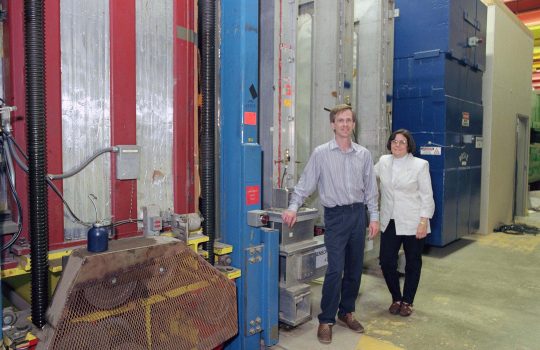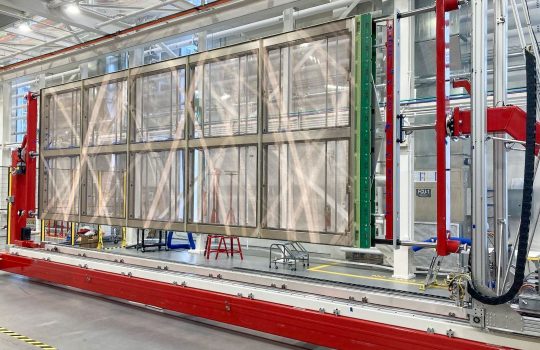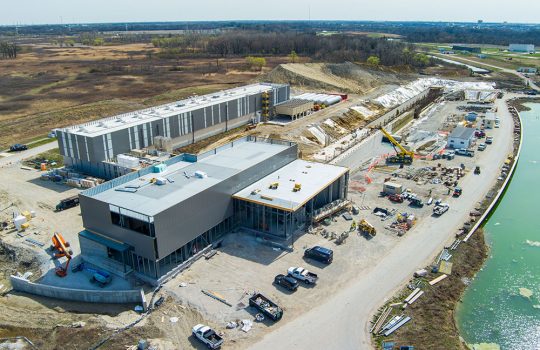Editor’s note: Today in Washington, D.C., UK Minister of State for Universities, Science, Research and Innovation Jo Johnson signed the first ever Science and Technology Agreement between the United Kingdom and the United States and announced a commitment of approximately $88 million for the international LBNF/DUNE project. We are pleased to distribute this press release on behalf of the British Embassy in Washington, D.C., and the U.S. State Department.
The U.S. Department of Energy’s Fermi National Accelerator Laboratory is the host laboratory for the LBNF/DUNE project, which will use Fermilab’s world-leading accelerator complex to send a beam of ghostly particles called neutrinos 800 miles through Earth to a massive detector that will be built a mile below the surface at the Sanford Underground Research Facility in South Dakota.
More than a thousand scientists from institutions in more than 30 countries around the world contribute to the LBNF/DUNE project. The UK has been an essential partner in the experiment since its inception, and the collaboration includes scientists from 16 UK institutions. The U.S. contribution to LBNF/DUNE is supported by the U.S. Department of Energy.
“The United Kingdom has long been a leader in this area of science, starting with Ernest Rutherford in the early 20th century,” said Fermilab Director Nigel Lockyer. “This agreement ensures that LBNF/DUNE will have great scientific and technical strength on the team as we chart the bright future for neutrino research.”
Joint statement by the governments of the United States of America and United Kingdom of Great Britain and Northern Ireland on the U.S.-U.K. Science and Technology Agreement

The DUNE neutrino beam will travel 1,300 kilometers (800 miles) through Earth from Fermilab in Illinois to Sanford Underground Research Facility in South Dakota. Illustration: Sandbox Studio/Fermilab
U.S. Acting Assistant Secretary of State for Oceans and International Environmental and Scientific Affairs Judith G. Garber and UK Minister of State for Universities, Science, Research and Innovation Jo Johnson signed the U.S.-UK Science and Technology Agreement on Sept. 20 in Washington, D.C. The signing ceremony marks the first ever umbrella agreement between the United States and United Kingdom outlining a commitment to collaborate on world-class science and innovation. Accompanying Jo Johnson on the visit to the United States was Chief Executive Designate at U.K. Research and Innovation Sir Mark Walport.
Expanding the frontiers of physics
The first major project of the agreement is UK investment in the Long-Baseline Neutrino Facility (LBNF) and Deep Underground Neutrino Experiment (DUNE), for which the UK government has confirmed approximately $88 million in funding. Construction for LBNF/DUNE is expected to create an estimated 4,000 jobs in the United States, about 2,000 in South Dakota and 2,000 in Illinois. The $88 million in funding makes the UK the largest country investor in the project outside of the United States.
The LBNF/DUNE project aims to answer some of the most important questions in science and advance our understanding of the origin and structure of the universe. One aspect of study is the behavior of neutrinos and their antimatter counterparts, antineutrinos. The project could provide insight as to why we live in a matter-dominated universe and inform the debate on why the universe survived the Big Bang.
The UK is a major scientific contributor to the DUNE collaboration, with 14 UK universities and two Science and Technology Facilities Council laboratories providing essential expertise and components to the experiment and facility. UK involvement in the project will also provide opportunities for UK industry to build capability in new and developing technologies, for example, in precision engineering, cryogenics and accelerator-based applications.
Improving digital research skills
Building on the U.S.-UK partnership, the U.S. Smithsonian Institution and the UK Arts Humanities Research Council are extending a successful history of partnerships by developing a new collaboration, based at the Smithsonian’s National Museum of American History, focused on increasing the use of digital research skills in museums. Enhancing these skills will benefit areas such as data analysis, curating, and accessibility of collections, and will also further audience engagement. This work will help achieve new best practices in digital scholarship and the application of digital technologies at research-led museums.
Breaking new ground together
The U.S.-UK scientific partnership is one of the world’s strongest, with bilateral collaborations resulting in 26 Nobel Prizes in science and economics. The investment in LBNF/DUNE is the most recent example from a long history of collaboration in industries ranging from aerospace to robotics to agriculture. U.S.-UK cooperation on science and innovation benefits both nations by sharing expertise to enhance our understanding of many important topics that have the potential to be world-changing, helping maintain our position as global leaders in research for years to come.
For further information, please contact Yoon Nam at namys@state.gov.
Read more from STFC: http://www.stfc.ac.uk/news/uk-signs-65m-science-partnership-agreement-with-us
Fermilab is America’s premier national laboratory for particle physics and accelerator research. A U.S. Department of Energy Office of Science laboratory, Fermilab is located near Chicago, Illinois, and operated under contract by the Fermi Research Alliance LLC, a joint partnership between the University of Chicago and the Universities Research Association, Inc. Visit Fermilab’s website at www.fnal.gov and follow us on Twitter at @Fermilab.
The DOE Office of Science is the single largest supporter of basic research in the physical sciences in the United States and is working to address some of the most pressing challenges of our time. For more information, please visit science.energy.gov.



